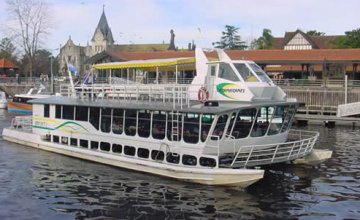Like an Explorer
Rural teacher, journalist, writer, politician and president of the Republic of Argentina (1868-74), Domingo Faustino Sarmiento was a precursor and a visionary of the delta we know today.
Sarmiento visited the delta for the first time while he was inspecting the area as the School Deparment Head, and he was so amazed at what he saw that he resolved to organize an exploration trip to incite citizens of Buenos Aires to populate the wonderful islands, rivers and creeks. This happened around 1850.
As a child, the Delta would disquiet him. Its maps and paintings reminded him of the famous Nile River and the channels of Venice, which he was lucky enough to visit during his trips. Reading the excellent book by Marcos Sastre, called “El Tempe Argentino” (first edited in 1858) was what he needed to make up his mind.
And so it was that some 500 people, including his friends Bartolomé Mitre and Carlos Pelegrini, left towards the islands in order to “civilize” them, as he would say. After the first expeditions and the first trips, more and more tourists would visit the area and become neighbors. Each one of the islands was divided into plots and occupied by the most wealthy families from the city of Buenos Aires, for whom the site turned out to be an ideal site to spend the weekend or to invest their savings.
Sarmiento`s Museum in Tigre
The House in the Delta
In 1860, Sarmiento already had his house in the Delta. According to history books, he occupied his island by shooting his firearm, like the American conquerors used to as they expelled the Indians from their territories.
He called it “Procida”, after the small island located off the shores of the Italian city of Naples, in southern Italy, and he built there a beautiful bridge which he called the same name as the famous bridge in Venice: “Rialto”.
The house is a small wooden building with a tile roof. According to historians such as María del Carmen Magaz and María Beatriz Arévalo, the ground floor was a free space, whereas the first floor would hold the only room in the house. The walls, built with pre-built boards, give us the idea that this is a much more elaborated architecture than meets the eye.
After almost thirty years of living in the Delta, Sarmiento himself kept insisting on the logic of the wooden houses. “Neither stone nor bricks” he summarises in an article entitled “Architecture and Island Sceneries” (1885) published in one of the most important newspapers in the City of Buenos Aires of those days.
“The willow is the ideal building material at the Delta. The news introduced into the islands is the wooden house built in the American style. A progress we would like to introduce all through our country” he would assert. However, the luxuries of European architecture reached the Delta and impregnated it with the romanticism and the glamour which American functionalism lacked.
Sarmiento died in 1895. Carlos Delcasse purchased the house and then donated it to a public welfare institution, which in turn donated it to the Education National Council. In 1966, a decree passed by President Illía declared it National Historical Monument and, therefore, today it is preserved in the same shape as the rest of the Delta wooden houses. Anyway, the fact that all of them were built after Sarmiento’s house must be born in mind.
Nowadays, the house works as a museum and library. According to the Municipality of Tigre, which was in charge of building the the glass structure around it in order to protect it from the inclemencies of the weather and the passing of time, approximately 50 thousand people reach this place every weekend attracted by the crystal box shining in the horizon.
Pablo Etchevers
Gentileza Vivitigre.gob.ar
Contact of the excursion or tour
Ente Municipal de Turismo de Tigre
Estación Fluvial de Tigre, Tigre, Buenos Aires, Agentina
Phone: +54 11-45124497



























